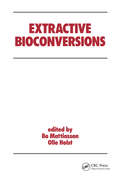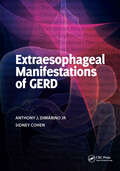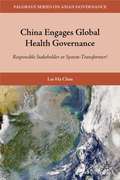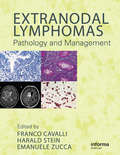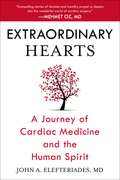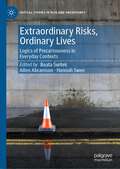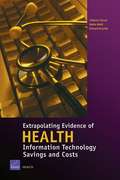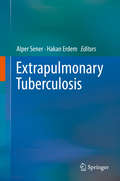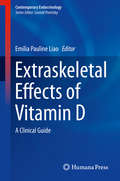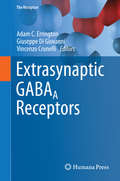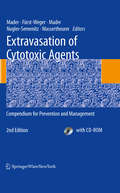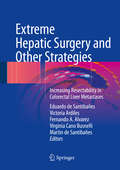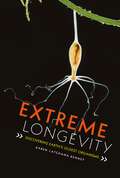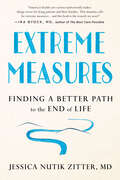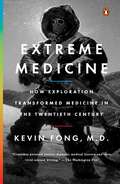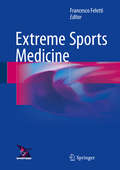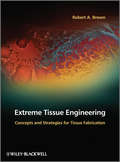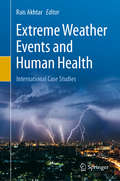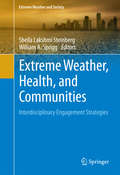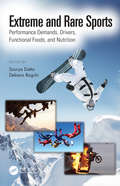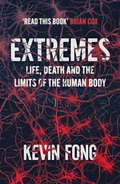- Table View
- List View
Extractive Bioconversions
by B. MattiassonContributors from European and US universities and corporations review recent developments in the integration of downstream processing and bioconversion, describing their experience with many separation technologies, including some still in the experimental stage. The topics include the construction
Extraesophageal Manifestations of GERD
by Sidney Cohen Anthony J. DiMarino, Jr.In the past 30 years, gastroesophageal and reflux disease (GERD) has become an important area of clinical medicine. GERD has gradually become associated with other common but unexplained disorders. These conditions have been designated as the extraesophageal manifestations of GERD.Dr. Anthony J. DiMarino, Jr. and Dr. Sidney Cohen and their contributors have written Extraesophageal Manifestations of GERD with the purpose to identify associations with conditions like hoarseness, laryngeal cancer, sleep disorders, and dental caries, and to explore possible causation and mechanisms of disease or possible noncausal relationships. The extraesophageal disorders have become widely accepted in clinical practice. The evidence supporting the pathogenesis of these conditions falls into three major categories: guilt by association, observed mechanistic studies, and therapeutic response to treatment.Inside the pages of Extraesophageal Manifestations of GERD the reader will find recognition and balance in treating patients with common symptom-based disorders. Final resolution of some of the controversies inherent in these associations may require advanced diagnostic tools and advanced pharmacological therapies.With chapters written by experts in the fields of medicine, pediatrics, otolaryngology, and dentistry, Extraesophageal Manifestations of GERD will be a must have for gastroenterologists, internal medicine residents, surgeons, otolaryngologists, and pediatricians.
Extramural Shakespeare
by Lai-Ha ChanThis book explores public health in China in particular the management of the HIV/AIDS epidemic, with the goal of understanding China's compliance with and resistance to the norms and rules embedded in the global health regime.
Extranodal Lymphomas: Pathology and Management
by Franco Cavalli Harald Stein Emanuele ZuccaLymphomas classically manifest themselves in the lymph nodes but can also present in other bodily tissues or systems; the organ where exactly they present may make a very great difference to the strategy that should be adopted for their management. This topic has only recently been consistently addressed as an issue on its own, apart from the rest
Extraordinary Chinese Medicine: The Extraordinary Vessels, Extraordinary Organs, and the Art of Being Human
by Thomas Richardson William R. MorrisPresenting a new model that explains the links between our extraordinary vessels and organs, this innovative guide shows how they relate to Daoist cosmology. Offering new insights into the unity within Chinese medicine, it helps practitioners and students of Daoism improve their theoretical understanding, as well as their practice.
Extraordinary Hearts
by John A. ElefteriadesCardiac surgeon John A. Elefteriades, one of Men's Health magazine's ten best doctors in America, shares moving patient stories and lessons about the human heart. The human heart is a paradox, incredibly strong yet surprisingly fragile. And while stories that reveal its symbolic characteristics abound, there are far fewer that laud its physical capabilities, which are perhaps even more profound. Dr. Elefteriades, one of the most respected cardiac surgeons in America, has treated more than 10,000 patients in his distinguished career. Now, for the first time, he shares fascinating stories of his most memorable patients and cases--patients who have challenged him technically and moved him emotionally, patients who have enriched his life and expanded his horizons while he cared for their hearts. By detailing heart conditions and cardiac reparative procedures with specific yet accessible medical narratives, Dr. Elefteriades encapsulates the beauty, complexity, and majesty of the human heart. But there is far more to this organ--and these stories--than a collection of veins, arteries, and valves. These are stories of courage, miracles, and the bravery of patients (some famous and others not) and their families when facing nearly insurmountable challenges, offering a thought-provoking, informative, and at times heart-wrenching study of the resilience of both the human body and spirit.
Extraordinary Risks, Ordinary Lives: Logics of Precariousness in Everyday Contexts (Critical Studies in Risk and Uncertainty)
by Allen Abramson Beata Świtek Hannah SweeThis book untangles the relationship between expert categorisations of risk and the on-the-ground experiences of untrained ‘ordinary’ people who may be routinely subjected to significant danger in a variety of extraordinary contexts. It considers political, ethical and moral dimensions of risk and calls for more targeted ethnographic research, designed to reveal how grass-roots risk dispositions and practice intersect with official discourses, individual agency and community resilience.
Extrapolating Evidence of Health Information Technology Savings and Costs
by Federico Girosi Robin C. Meili Richard ScovilleProvides the technical details and results of one component of a study to better understand the role and importance of Electronic Medical Record Systems (EMR-S) in improving health and reducing healthcare costs--the national-level efficiency savings that would be brought about by using Healthcare Information Technology-and the costs the nation would have to incur to realize those savings.
Extrapulmonary Tuberculosis
by Alper Sener Hakan ErdemThis book brings awareness to a neglected condition that is nevertheless prevalent world-wide. Much focus is justly given to pulmonary tuberculosis, one of the key medical scourges of humanity, but this disease also often manifests itself in organs outside of the lungs. There is however a surprising lack of information available on extrapulmonary TB, which this book aims to remedy. Specifically, research, as well as epidemiology, diagnosis, and treatment options, are discussed in detail by an international list of experts. This comprehensive product serves as a valuable resource to numerous fields of medicine due to the presence of extrapulmonary tuberculosis throughout the human body.
Extraskeletal Effects of Vitamin D: A Clinical Guide (Contemporary Endocrinology)
by Emilia Pauline LiaoWhile the skeletal effects of vitamin D are well-documented, the role and importance of vitamin D outside of bone health has not been well-established. Vitamin D receptors are located in nearly every tissue of the body, and low levels of vitamin D are associated with a range of various diseases. This book provides an in-depth examination of these extraskeletal effects of vitamin D and the associations between vitamin D deficiency and various disease states. Beginning with a review of the biochemistry and physiology of vitamin D, subsequent chapters investigate its relationship to autoimmune and infectious diseases, various forms of cancer, endocrine issues such as diabetes, obesity and reproductive function, cardiovascular disease and muscle weakness. Concluding chapters discuss the role of vitamin D in neurological disorders, including Alzheimer's Disease, and cognitive function. Focusing on extraskeletal effects only across a range of conditions, Extraskeletal Effects of Vitamin D will be an important resource for clinical endocrinologists and primary care physicians.
Extrasynaptic GABAA Receptors
by Giuseppe Di Giovanni Adam C. Errington Vincenzo CrunelliGABA is the principal inhibitory neurotransmitter in the CNS and acts via GABAA and GABAB receptors. Recently, a novel form of GABAA receptor-mediated inhibition, termed "tonic" inhibition, has been described. Whereas synaptic GABAA receptors underlie classical "phasic" GABAA receptor-mediated inhibition (inhibitory postsynaptic currents), tonic GABAA receptor-mediated inhibition results from the activation of extrasynaptic receptors by low concentrations of ambient GABA. Extrasynaptic GABAA receptors are composed of receptor subunits that convey biophysical properties ideally suited to the generation of persistent inhibition and are pharmacologically and functionally distinct from their synaptic counterparts. This book highlights ongoing work examining the properties of recombinant and native extrasynaptic GABAA receptors and their preferential targeting by endogenous and clinically relevant agents. In addition, it emphasizes the important role of extrasynaptic GABAA receptors in GABAergic inhibition throughout the CNS and identifies them as a major player in both physiological and pathophysiological processes.
Extravasation of Cytotoxic Agents
by Ines Mader Elisabeth Nogler-Semenitz Patrizia R. Fürst-Weger Robert M. Mader Sabine Wassertheurer Birte TwisselmannThe extravasation of cytotoxic agents can result in severe local tissue damage and medical emergencies during tumour therapy. This revised compendium is intended to help clinicians assess any situation speedily and with certainty. The general section of the book includes topics such as predisposition, prevention, type of harm, general measures in handling extravasated drugs, specific antidotes, and documentation. In the 2nd edition, the scientific information contained in the general section and relating to the actual substances has been updated. The substance specific part of the book includes detailed instructions on handling more than 50 cytotoxic drugs, to initiate targeted measures. Templates for an extravasation set, overview tables, documentation sheets, and patient information, as we as a CD-ROM are included to support clinical practice. The book is the outcome of a consensus of an interdisciplinary working group that has collected and systematically reviewed all published literature on the topic.
Extreme Biomimetics
by Hermann EhrlichThis book discusses the current direction of the research approach to extreme biomimetics through biological materials-inspired chemistry and its applications in modern technology and medicine. It is a resource covering topics of extreme (psychrophilic and thermopilic) biomineralization, solvothermal and hydrothermal chemistry of metal oxides and nanostructured composites, and bioinspired materials science in a diverse areas. The authors review the current advances in the extreme biomimetics research field and describe various approaches introduced and explored by their respective laboratories. * Details the basic principles of extreme biomimetics approach for design of new materials and applications; * Includes numerous examples of the hierarchical organization of hydrothermally or psychrophilically obtained biocomposites, structural bioscaffolds, biosculpturing, biomimetism, and bioinspiration as tools for the design of innovative materials; * Describes and details the principles of extreme biomimetics with respect to metallization of chemically and thermally stable biopolymers.
Extreme Hepatic Surgery and Other Strategies
by Eduardo De Santibañes Victoria Ardiles Fernando A. Alvarez Virginia Cano Busnelli Martin De SantibañesThis book describes the diagnoses; staging and management of patients with colorectal liver metastases initially considered unresectable and portrays the different strategies to increase resectability along with their tactics and tricks. Colorectal carcinoma is the third most commonly diagnosed cancer in the world and according to recent cancer statistics around 1. 23 million patients are diagnosed each year. Of these patients, approximately 50% will develop liver metastases during the course of their disease and around 15-25% are found to have stage IV disease at diagnosis. Liver resection has been recognized as the treatment of choice for these patients, offering overall 5-year survival rates of up to 50-60% and the only hope for cure. However, at diagnosis only 10-20% of these patients are possibly amenable to surgical resection with curative intent. The possibility to achieve an R0 resection is many times limited by the amount and quality of the future liver remnant (FLR), being posthepatectomy liver failure (PHLF) the most feared and severe complication after major liver resections. With the years, diverse strategies have been developed with the intention to increase resectability by increasing the future liver remnant and/or reducing tumor size, e. g. ALPPS. Along with these techniques, associated surgeries are developed including multivisceral resections, which broadens even more the resectability for patients.
Extreme IR: Extraordinary Cases in Interventional Radiology and Endovascular Therapies
by Ziv J HaskalThis book presents 101 unique and extraordinary cases in interventional radiology (IR) and endovascular therapy. Extreme IR is an internationally recognized event that Dr. Ziv Haskal created and held in early 2000's at mountaintop venues, then at successive Society of Interventional Radiology annual conference meetings, and later, published monthly within the Journal of Vascular and Interventional Radiology (JVIR) for which he was editor-in-chief for 10 years. The ever-popular Extreme IR sessions at conferences have drawn more than 5,000 attendees. Cases are presented in a rapid-fire format designed to maximize relevancy, excitement, and unique knowledge. This book aims to replicate that experience for a wider audience. The book is divided into twelve sections, including venous, portal hypertension, and biliary, arterial, oncology, etc. cases. Most cases span two pages and include large, illustrative images with bullet-pointed text to present essential information in a concise and focused fashion. The global list of authors exemplifies the extraordinary breadth of the cases for interventional radiologists, endovascular specialists. It is ideal for interventional radiologists and endovascular specialists at all levels of seniority and training.
Extreme Longevity: Discovering Earth's Oldest Organisms
by Karen Latchana KenneyMeet the science experts who study specimens of extreme longevity in both the plant and animal kingdoms, such as the 80,000-year-old root system of Pando (a colony of male quaking aspens), 11,000-year-old deep-sea sponges, and 400-year-old sharks. Learn about technologies used to determine age and longevity, including DNA sampling, growth rings, and radiocarbon dating. See how scientists located these long-lived species were and why and how they resist disease and aging. And delve into how scientists are using what they know about aged plants and animals to research how we can promote longevity in humans.
Extreme Measures: Finding a Better Path to the End of Life
by Jessica Nutik ZitterAn ICU and Palliative Care specialist featured in the Oscar-nominated Netflix documentary Extremis offers a framework for a better way to exit life that will change our medical culture at the deepest levelIn medical school, no one teaches you how to let a patient die. Jessica Zitter became a doctor because she wanted to be a hero. She elected to specialize in critical care—to become an ICU physician—and imagined herself swooping in to rescue patients from the brink of death. But then during her first code she found herself cracking the ribs of a patient so old and frail it was unimaginable he would ever come back to life. She began to question her choice. Extreme Measures charts Zitter’s journey from wanting to be one kind of hero to becoming another—a doctor who prioritizes the patient’s values and preferences in an environment where the default choice is the extreme use of technology. In our current medical culture, the old and the ill are put on what she terms the End-of-Life Conveyor belt. They are intubated, catheterized, and even shelved away in care facilities to suffer their final days alone, confused, and often in pain. In her work Zitter has learned what patients fear more than death itself: the prospect of dying badly. She builds bridges between patients and caregivers, formulates plans to allay patients’ pain and anxiety, and enlists the support of loved ones so that life can end well, even beautifully. Filled with rich patient stories that make a compelling medical narrative, Extreme Measures enlarges the national conversation as it thoughtfully and compassionately examines an experience that defines being human.
Extreme Medicine
by Kevin FongAnesthesiologist, intensive care expert, and NASA adviser Kevin Fong explores how physical extremes push human limits and spawn incredible medical breakthroughs.
Extreme Medicine: How Exploration Transformed Medicine in the Twentieth Century
by Kevin FongAnesthesiologist, intensive care expert, and NASA adviser Kevin Fong explores how physical extremes push human limits and spawn incredible medical breakthroughsLittle more than one hundred years ago, maps of the world still boasted white space: places where no human had ever trod. Within a few short decades the most hostile of the world’s environments had all been conquered. Likewise, in the twentieth century, medicine transformed human life. Doctors took what was routinely fatal and made it survivable. As modernity brought us ever more into different kinds of extremis, doctors pushed the bounds of medical advances and human endurance. Extreme exploration challenged the body in ways that only the vanguard of science could answer. Doctors, scientists, and explorers all share a defining trait: they push on in the face of grim odds. Because of their extreme exploration we not only understand our physiology better; we have also made enormous strides in the science of healing.Drawing on his own experience as an anesthesiologist, intensive care expert, and NASA adviser, Dr. Kevin Fong examines how cuttingedge medicine pushes the envelope of human survival by studying the human body’s response when tested by physical extremes. Extreme Medicine explores different limits of endurance and the lens each offers on one of the systems of the body. The challenges of Arctic exploration created opportunities for breakthroughs in open heart surgery; battlefield doctors pioneered techniques for skin grafts, heart surgery, and trauma care; underwater and outer space exploration have revolutionized our understanding of breathing, gravity, and much more. Avant-garde medicine is fundamentally changing our ideas about the nature of life and death.Through astonishing accounts of extraordinary events and pioneering medicine, Fong illustrates the sheer audacity of medical practice at extreme limits, where human life is balanced on a knife’s edge. Extreme Medicine is a gripping debut about the science of healing, but also about exploration in its broadest sense—and about how, by probing the very limits of our biology, we may ultimately return with a better appreciation of how our bodies work, of what life is, and what it means to be human.
Extreme Sports Medicine
by Francesco FelettiThis technically oriented book on medicine as applied to extreme sports offers broad coverage of the field extending well beyond the usual focus on major trauma and acute injuries. In addition to the injuries and diseases associated with individual extreme sports, this book also addresses the topics of psychology, dermatology, ophthalmology, infectious diseases, physiology, nutrition, training, injury prevention strategies, rehabilitation, doping, treatment in hostile environments, and legal aspects. Innovative and less frequently considered topics are also discussed, such as recent advances in protective equipment and materials, the effects of exposure on whole-body vibration, and cold exposure risk management. More than 60 of the most authoritative experts from across the world have contributed to this book, drawing on their personal experiences and including practical examples whenever relevant. Both subject matter and illustrations have been selected with the utmost care, the latter including photographs of world-class athletes. The book's multidisciplinary approach to the subject ensures that it will be relevant to a wide readership.
Extreme Tissue Engineering
by Robert A. BrownHighly Commended at the BMA Book Awards 2013Extreme Tissue Engineering is an engaging introduction to Tissue Engineering and Regenerative Medicine (TERM), allowing the reader to understand, discern and place into context the mass of scientific, multi-disciplinary data currently flooding the field. It is designed to provide interdisciplinary, ground-up explanations in a digestible, entertaining way, creating a text which is relevant to all students of TERM regardless of their route into the field.Organised into three main sections: chapters 1 to 3 introduce and explain the general problems; chapters 4 to 6 identify and refine how the main factors interact to create the problems and opportunities we know all too well; chapters 7 to 9 argue us through the ways we can use leading-edge (extreme) concepts to build our advanced solutions.Students and researchers in areas such as stem cell and developmental biology, tissue repair, implantology and surgical sciences, biomaterials sciences and nanobiomedicine, bioengineering, bio-processing and monitoring technologies - from undergraduate and masters to doctoral and post-doctoral research levels - will find Extreme Tissue Engineering a stimulating and inspiring text.Written in a fluid, entertaining style, Extreme Tissue Engineering is introductory yet challenging, richly illustrated and truly interdisciplinary.
Extreme Weather Events and Human Health: International Case Studies
by Rais AkhtarThis edited book assesses the impacts of various extreme weather events on human health and development from a global perspective, and includes several case studies in various geographical regions around the globe. Covering all continents, it describes the impact of extreme weather conditions such as flash floods, heatwaves, cold waves, droughts, forest fires, strong winds and storms in both developing and developed countries. The contributing authors also investigate the spread of diseases and the risk to food security caused by drought and flooding. Further, the book discusses the economic damage resulting from natural disasters including hurricanes. It has been estimated that in 2017 natural disasters and climate change resulted in economic losses of 309 billion US dollars. Scientists also predict that if nothing is done to curb the effects of climate change, in Europe the death toll due to weather disasters could rise 50-fold by the end of the 21st century, with extreme heat alone causing more than 150,000 deaths a year, as the report on global warming of 1.5°C warns that China, Russia and Canada’s current climate policies would steer the world above a catastrophic 5°C of warming by the end of 2100. As such, the book highlights how the wellbeing of different populations is threatened by extreme events now and in the foreseeable future.
Extreme Weather, Health, and Communities
by Sheila Lakshmi Steinberg William A. SpriggThis volume presents a unique interdisciplinary approach, drawing on expertise in both the natural and social sciences. A primary goal is to present a scientific and socially integrated perspective on place-based community engagement, extreme weather, and health. Each year extreme weather is leading to natural disasters around the world and exerting huge social and health costs. The International Monetary Fund (2012) estimates that since 2010, 700 worldwide natural disasters have affected more than 450 million people around the globe. The best coping strategy for extreme weather and environmental change is a strong offense. Communities armed with a spatial understanding of their resources, risks, strengths, weaknesses, community capabilities, and social networks will have the best chance of reducing losses and achieving a better outcome when extreme weather and disaster strikes.
Extreme and Rare Sports: Performance Demands Drivers Functional Foods And Nutrition
by Debasis Bagchi Sourya DattaTwo crucial components of a healthy life are nutrition and exercise. The importance of appropriate diet, food and nutrition are extremely important to be successful in sports, and, especially, in extreme sports. Extreme sport is an activity where a participant must demonstrate both mental and physical skills. This type of activity provides an adrenaline rush to individuals who are part of the "community of extreme sportsmen." Extreme sports provide opportunity for individuals to be active and fit with added enjoyment of partaking in a fun activity. Extreme sports in conjunction with proper nutrition helps to boost immunity and resistance against common infections. Studies have also exhibited that sports and exercise activities help in managing effective work-life balance as well. Extreme and Rare Sports: Performance Demands, Drivers, Functional Foods, and Nutrition provides a comprehensive treatise on extreme sports emphasizing the importance of nutrition and research-driven nutraceutical supplements in injury prevention and treatment. The book presents information on the nutritional requirements of sports activities on land, in water, or with high altitude-base. It covers a wide variety of definitions, philosophies, thoughts and practices involved with structurally diverse extreme sports. Features: Discusses specific food and nutritional requirements in extreme sports Provides information on the importance of functional foods, nutrition and structurally diverse phytonutrients for different sports Features information on Olympic and diverse extreme sports Details the importance of hydration and use of gelatin; skeletal muscle damage and recovery from eccentric contractions; and information on dietary supplements and antioxidants Presents analysis on growth, marketing, techniques, and future of extreme sports
Extremes: Life, Death and the Limits of the Human Body
by Kevin FongIn anaesthetist Dr Kevin Fong's television programmes he has often demonstrated the impact of extremes on the human body by using his own body as a 'guinea pig'. So Dr Fong is well placed to share his experience of the sheer audacity of medical practice at extreme physiological limits, where human life is balanced on a knife edge. Through gripping accounts of extraordinary events and pioneering medicine, Dr Fong explores how our body responds when tested by the extremes of heat and cold, vacuum and altitude, age and disease. He shows how science, technology and medicine have taken what was once lethal in the world and made it survivable. This is not only a book about medicine, but also about exploration in its broadest sense - and about how, by probing the very limits of our biology, we may ultimately return with a better appreciation of how our bodies work, of what life is, and what it means to be human.
